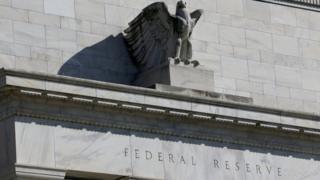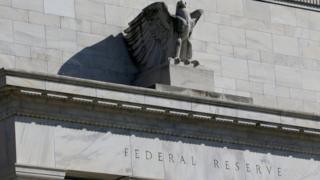Why the Fed’s interest rate move matters
The Federal Reserve, the US central bank, is expected to cut its main interest rates on Wednesday. …

 Image copyright Reuters
Image copyright Reuters The Federal Reserve, the US central bank, has, as expected, cut its main interest rates at a meeting in Washington on Wednesday.
The aim is to stimulate the US economy and get inflation closer to the Fed’s target of 2%. But it will have ramifications far beyond US shores.
Why does Fed policy matter for the rest of the world?
There are two general answers.
One is that the US economy’s performance is important for the rest of us. If the Fed gets it wrong the US could end up underperforming, which would be bad news for many other countries.
The second point is that Fed policy can have an impact through financial markets by affecting currency exchange rates, interest rates and international flows of investment money.
What difference does the health of the US economy make for the rest of us?
For most countries on the planet, the US is an important export market – for many, the largest of all.
If the US has a recession, it will buy less stuff from abroad than it would have if growth had been maintained. Its immediate neighbours, Canada and Mexico, are particularly exposed. For both, more than three-quarters of their exports go to the US.
The UK is also at some risk from economic storms in the US, although not to the extent of Canada and Mexico. The US is the largest single country export destination for the UK, though the UK exports much more to the countries of the EU taken together. The US accounts for about 13% of UK exports.
What is the Fed’s role in keeping the economy healthy?
The Federal Reserve has a mandate from the US Congress to promote maximum employment and stable prices.
It raises interest rates if inflation is too high, or it thinks it is heading that way. It cuts rates if it thinks there is a danger of economic growth slowing too much or inflation being too low.
Rate cuts make it more attractive for business to borrow to invest and households to borrow to spend. The Fed is perhaps the key player in trying to prevent a recession and promoting a recovery if there is a downturn.
The Fed has started reducing interest rates in an attempt to maintain solid economic growth in the US.
Growth has slowed, though there does not appear to be an imminent danger of the economy actually contracting. That said, there have been some warning signs in the financial markets that often do signal a recession is not that far away.
The rest of the world keeps an eye on how well the Fed is managing to keep that balance between growth and inflation, since a healthy US economy reduces the risk of the rest of the world catching a dose of economic slowdown.
What impact does the Fed have on currency markets?
Cuts in interest rates in any country tend to make its currency lose value against others.
That is because lower interest rates mean there is less money to be made by investing in that country’s assets, since they’re yielding less interest. Primarily that means government bonds.
If investors are less keen to buy, for example US government bonds, there is less demand for the currency needed to buy them. So the currency concerned, the dollar in this case, tends to lose value.
Currency movements affect how competitive countries’ exports are. If US rates are cut and the dollar weakens, American exports become cheaper, and imports to the US from elsewhere go up in price. That can have a knock on impact on the price of goods on shop shelves, in other words inflation.
But for other countries importing goods priced in dollars, the impact can be to reduce inflation. When the dollar is weaker it costs other countries less in their domestic currency to buy dollar-priced goods. And that’s not just American exports, lots of commodities including oil are priced in dollars.
What about the impact on international investment flows?
When an economy as large as the US changes its interest rates, it is possible for the subsequent movement of investment funds to be disruptive.
There was an episode in 2013 when the Fed started to consider reducing its quantitative easing programme. That programme involved creating new money to buy financial assets such as government bonds. Reducing QE was in some ways akin to raising interest rates.
The plan was to “taper” the quantitative easing, and the result for emerging economies such as India and Indonesia came to be known as the “taper tantrum”.
Large amounts of money left emerging market economies, and there were concerns at the time that it might even lead to a new financial crisis in those countries. In the event, that did not happen.
This time, because interest rates are likely to be cut, it is more likely that money will go into emerging economies. That can sometimes lead to financial instability (or unsustainable bubbles). That is not an immediate concern now, but it is a reason why governments around the world need to keep a careful eye on what happens in the US.



